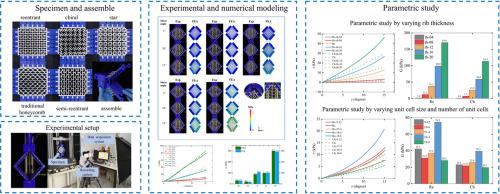Shear behavior of auxetic and non-auxetic cellular metamaterial
IF 9.4
1区 工程技术
Q1 ENGINEERING, MECHANICAL
International Journal of Mechanical Sciences
Pub Date : 2025-09-26
DOI:10.1016/j.ijmecsci.2025.110891
引用次数: 0
Abstract
Classical cellular auxetic materials typically exceed the linear elastic small-deformation regime, leaving the superiority of their shear performance unclear. Therefore, it is essential to investigate the shear performance of classical auxetic structures and compare their shear resistance with non-auxetic structures. In this work, a shear deformation performance test was conducted on three classical auxetics (reentrant structure (Re), Star lattice (St), and chiral lattice (Ch)) and two non-auxetic counterparts (Honeycomb structure (Ho), near-zero Poisson’s ratio semi-reentrant structure (Se)) experimentally and numerically. The optimal mesh size was determined via grid convergence analysis. Then, the effective shear modulus of the structures was measured via the modular picture-frame apparatus. Deformation mode indicate that shear force magnitude depends on rib arrangement within the unit cell. Parametric analyses were conducted on the reentrant structure and chiral lattice by varying rib thickness, unit cell size, and number of unit cells. The results show that auxetic structures exhibit significant differences in shear modulus compared to two non-auxetic structure, with far lower shear stress during deformation. The rib thickness of the unit cell had the greatest impact on shear stress. This study highlights that the advantage of auxetic structures lies not in enhanced shear modulus but in their exceptional deformation capacity. Leveraging this property, auxetic structures offer innovative potential applications in civil engineering and aerospace engineering, such as architectural membranes and aircraft wing skins.

生长型和非生长型细胞超材料的剪切特性
经典的胞状抗剪材料通常超出线弹性小变形范围,因此其抗剪性能的优越性并不明显。因此,有必要研究经典减震结构的抗剪性能,并将其与非减震结构的抗剪性能进行比较。在这项工作中,对三种经典的形变结构(可重入结构(Re)、星形晶格(St)和手性晶格(Ch))和两种非形变结构(蜂窝结构(Ho)、近零泊松比半可重入结构(Se))进行了剪切变形性能实验和数值测试。通过网格收敛分析确定最优网格尺寸。然后,通过模组化相框仪测量结构的有效剪切模量。变形模式表明,剪切力的大小取决于单元格内肋的排列。通过改变肋厚、单元格大小和单元格数对重入结构和手性晶格进行了参数化分析。结果表明:与两种非塑性结构相比,塑性结构的剪切模量差异显著,变形过程中的剪切应力要小得多;单元胞肋厚度对剪切应力的影响最大。本研究强调了减振结构的优势不在于增加剪切模量,而在于其特殊的变形能力。利用这一特性,消声结构在土木工程和航空航天工程中提供了创新的潜在应用,例如建筑膜和飞机机翼蒙皮。
本文章由计算机程序翻译,如有差异,请以英文原文为准。
求助全文
约1分钟内获得全文
求助全文
来源期刊

International Journal of Mechanical Sciences
工程技术-工程:机械
CiteScore
12.80
自引率
17.80%
发文量
769
审稿时长
19 days
期刊介绍:
The International Journal of Mechanical Sciences (IJMS) serves as a global platform for the publication and dissemination of original research that contributes to a deeper scientific understanding of the fundamental disciplines within mechanical, civil, and material engineering.
The primary focus of IJMS is to showcase innovative and ground-breaking work that utilizes analytical and computational modeling techniques, such as Finite Element Method (FEM), Boundary Element Method (BEM), and mesh-free methods, among others. These modeling methods are applied to diverse fields including rigid-body mechanics (e.g., dynamics, vibration, stability), structural mechanics, metal forming, advanced materials (e.g., metals, composites, cellular, smart) behavior and applications, impact mechanics, strain localization, and other nonlinear effects (e.g., large deflections, plasticity, fracture).
Additionally, IJMS covers the realms of fluid mechanics (both external and internal flows), tribology, thermodynamics, and materials processing. These subjects collectively form the core of the journal's content.
In summary, IJMS provides a prestigious platform for researchers to present their original contributions, shedding light on analytical and computational modeling methods in various areas of mechanical engineering, as well as exploring the behavior and application of advanced materials, fluid mechanics, thermodynamics, and materials processing.
 求助内容:
求助内容: 应助结果提醒方式:
应助结果提醒方式:


